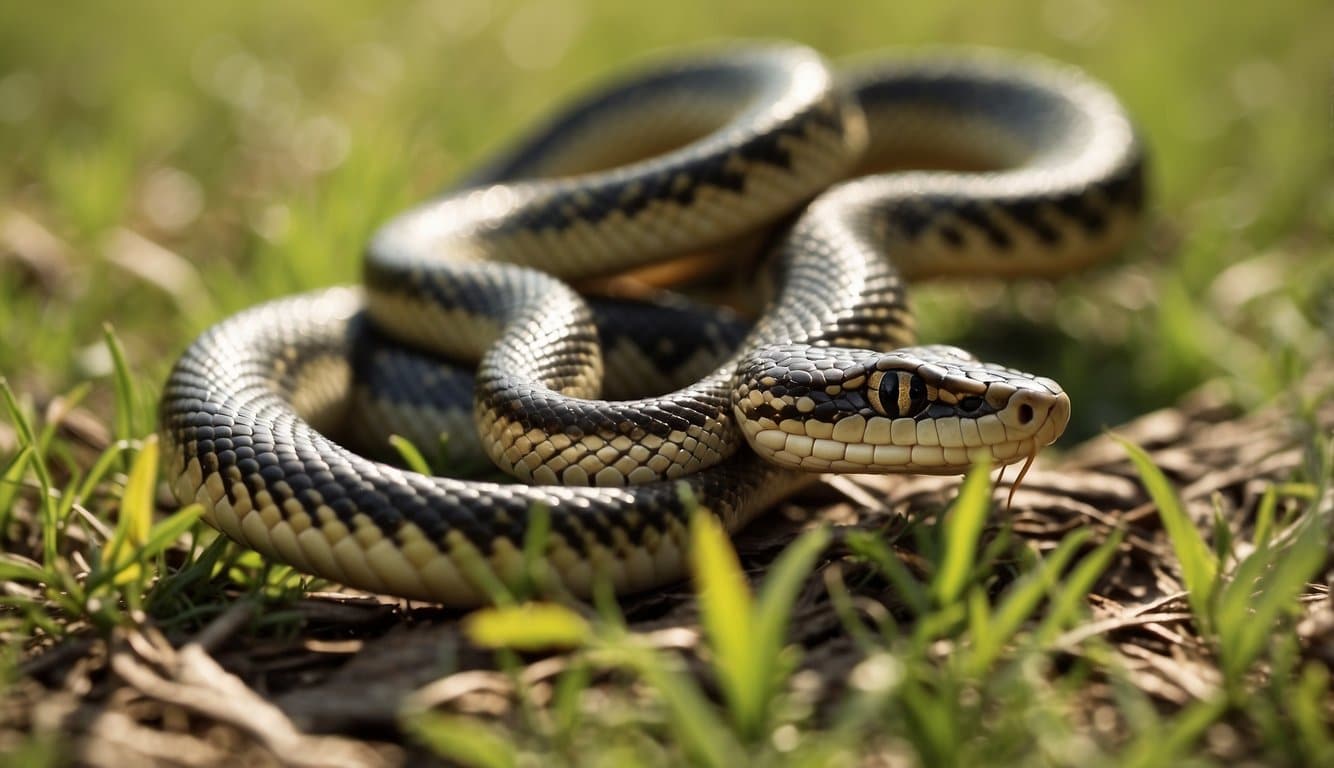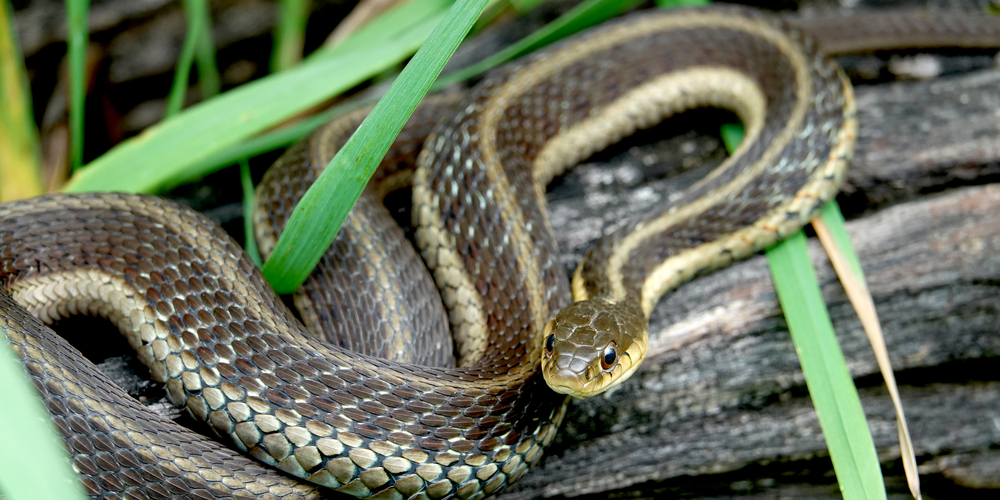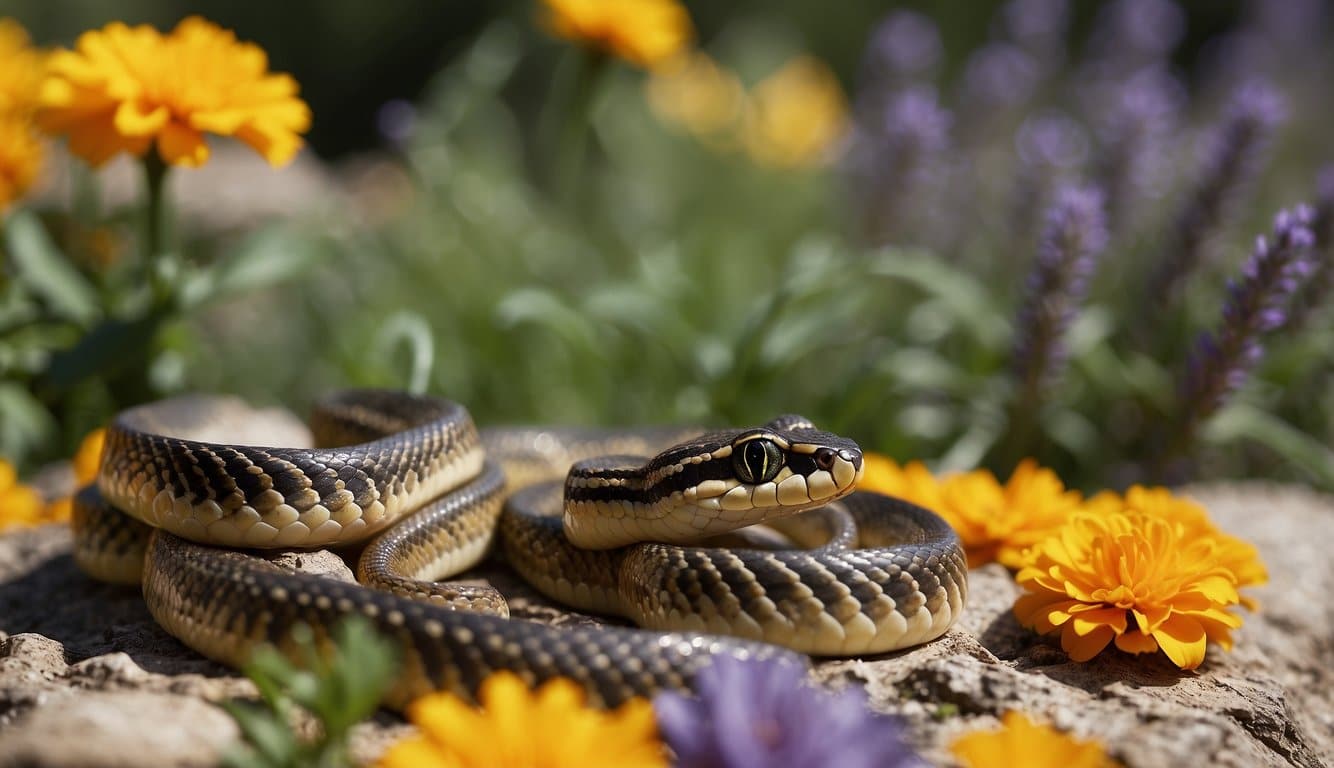Garter Snake Behavior: A Crash Course

Garter snakes, often found in your backyard, exhibit fascinating behaviors that reflect their adaptability and survival instincts.
Let’s explore their habitat preferences and diet, shedding light on the daily life of these common yet intriguing creatures.
Habitat Preferences
- Diverse Environments: You’ll find garter snakes thriving in a variety of habitats, ranging from moist grasslands to forests.
- Shelter Seeking: These snakes are adept at locating shelters, using burrows made by other animals, or creating their own among rocks, logs, and dense vegetation to protect themselves from predators and extreme weather conditions.
Diet and Hunting Patterns
- Opportunistic Feeders: Garter snakes have a diet that includes a wide array of prey, such as earthworms, amphibians, and fish. Their keen sense of smell assists them in tracking down their next meal.
- Hunting Techniques:
- Active Pursuit: Unlike some other snakes, garter snakes often actively pursue prey rather than waiting to ambush.
- Venom and Constriction: While they possess mild venom, it’s mainly effective on their small prey and not harmful to humans. They also use constriction to subdue larger prey items.
Garter Snake Bites
You can see in the video below, Garter Snakes do bite, but it’s not that bad.
When it comes to garter snakes, it’s crucial to recognize that they can bite, though such instances are infrequent and typically without serious consequences.
Frequency of Bites
- Rare Occurrences: Garter snakes are more inclined to slither away than confront humans. Bites tend to happen only when these snakes have no escape route.
- Harmless Nature: If bitten, the bite itself is usually mild, with minimal risk of severe injury.
Common Reasons for Biting
- Defensive Response: When garter snakes bite, it is often in self-defense. If a snake feels cornered or threatened, it may resort to biting.
- Accidental Provocation: Unintentional actions like stepping near a snake can induce stress, potentially leading to a bite.
Health and Safety: Quick Bites (Pun Intended)
Garter snakes are common across many regions, and understanding the health and safety aspects of their bites is crucial whether you’re a hiker, gardener, or simply enjoy the outdoors.
Are Garter Snake Bites Poisonous
Garter snakes are often mistakenly thought to be completely non-venomous, but they actually possess a mild venom.
However, their venom is not harmful to humans due to low toxicity and the absence of an effective delivery mechanism. Garter snakes lack the fangs that venomous snakes use to inject venom deeply. Therefore, garter snake bites are typically not dangerous, causing only minor symptoms such as:
- Swelling
- Itching
- Redness
Reaction Severity varies from person to person, and some may experience allergic reactions.
First Aid for Bites
If you receive a bite from a garter snake, appropriate first aid is important to prevent any complications:
- Clean the Wound:
- Wash the bite area with soap and water thoroughly to remove any bacteria.
- Pat the area dry with a clean cloth.
- Reduce Swelling:
- Apply a cold pack to the bite area to minimize swelling and discomfort.
- Monitor the Bite:
- Keep an eye on the bite for signs of infection or an increase in symptoms.
Remember to clean and care for the wound properly to prevent infection.
When to Seek Medical Attention
Though most garter snake bites don’t require a doctor’s visit, seek medical attention if you experience:
- Difficulty breathing
- Excessive swelling
- Symptoms of an allergic reaction
- Signs of infection such as red streaks, pus, or severe pain
It’s rare, but if you ever have concerns about a bite, calling 911 or contacting a medical professional is a sensible precaution.
Preventing Unwanted Encounters
To minimize your chances of an unwelcome surprise from a garter snake, it’s essential to engage in precautionary practices in your garden and reduce elements that might attract these reptiles to your space.
Safe Gardening Practices
- Wear Gloves and Long Pants: Always protect yourself by wearing thick gardening gloves and long pants to prevent bites if you accidentally come in contact with a garter snake.
- Be Vigilant: Before reaching into a new area, inspect it carefully for any hidden snakes.
- Keep the Garden Tidy: Eliminate clutter like piles of wood or leaves where snakes may hide.
Reducing Attractants
- Manage Compost: Ensure your compost is contained, as decomposing materials can attract rodents, which in turn can lure garter snakes looking for a meal.
- Control Insect Populations: Regularly treat your garden for insects to avoid creating a food source for these reptiles.
- Maintain Lawns: Keep your lawn closely mowed. Tall grasses can offer cover and hunting grounds for garter snakes.
Garter Snakes Add a Ton of Value to Your Yard
Understanding the balance between humans and garter snakes is essential for both conservation efforts and ensuring a peaceful coexistence.
The Role of Garter Snakes in the Ecosystem
- Pest Control: Garter snakes are natural pest controllers. They feed on rodents, amphibians, and insects, which helps to control the population of these species and maintain ecological balance.
- Biodiversity Indicators: Their presence indicates a healthy ecosystem. A diverse environment that supports garter snakes often supports a myriad of other wildlife species.
Fostering a Healthy Environment for Snakes
- Habitat Preservation: Protect biomes where garter snakes live to ensure their survival. This includes wetlands, grasslands, and forests, which must be kept free from pollution and degradation.
- Safe Interaction Methods:
- Learn how to identify garter snakes to avoid unnecessary fear or harm.
- Educate others on the importance of garter snakes and the safety of handling them, should it be necessary.
Frequently Asked Questions
In this section, you’ll find precise answers to common inquiries regarding garter snake bites, their effects on both humans and pets, and measures to treat and prevent them.
Can garter snake bites cause harm to humans?
Garter snakes are not typically dangerous to humans. Their bites may cause mild swelling or itching, but they are not venomous enough to cause serious harm. For more detailed information, you can read about Garter snake venom and safety.
Is it possible for a garter snake bite to be painful?
While a garter snake bite can be surprising, it is not usually severely painful. The sensation may be comparable to a small pinch or scratch. Discomfort is often mild and temporary.
What are the common signs and symptoms of a garter snake bite?
- Localized redness or slight swelling
- Minimal bleeding or scratch marks
- Itching or minor burning sensation
How should one treat a garter snake bite if it occurs?
- Clean the bite area gently with soap and water.
- Apply a bandage if necessary, to keep the area clean.
- Monitor for any signs of infection and consult a doctor if needed.
What precautions should be taken when dealing with garter snakes to avoid bites?
- Be aware of your surroundings, especially in areas where garter snakes are common.
- Wear gloves and long sleeves when handling or moving snakes.
- Avoid startling or threatening them, as this can provoke a bite.
How does a garter snake bite affect dogs and other pets?
Garter snake bites can cause mild reactions in dogs and other pets similar to those in humans, such as swelling or discomfort.
It’s crucial to monitor your pet for any unusual behavior after a bite and consult a veterinarian if you have concerns.
For advice on pet safety and well-being, check out Safety measures for pets around garter snakes.
Last update on 2025-04-19 / Affiliate links / Images from Amazon Product Advertising API




